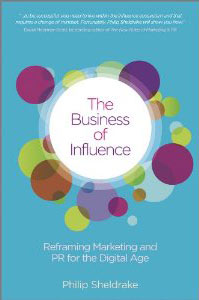This book will make practitioners in marketing, PR, advertising, communications, and any professional with the word digital in his title uncertain about the future of his discipline. Philip Sheldrake makes the case that the traditional boundaries of these professions must morph into a more holistic expertise, which he calls the influence professional. And while such professionals must retain their creative right-brain talents, they must become far more skilled in left-brained analytical competencies.
The convergence of markets, media, and technology raises the bar further. New business models, the proliferation of social media, the relative power shift from producers to consumers, and the overwhelming amount of structured and unstructured data make managing our businesses more challenging than ever. It seems that we increasingly know more and more about less and less. Change is constant, and accelerating.
What to do? The author proposes a creative, structured approach to the business of influence, which is to say, business itself. He identifies the interactions between stakeholders – businesses, employees, customers, competitors – and maps the primary influence flows among them. He provides a practical framework for seeing, and acting on, the drivers of value creation. He proposes an Influence Scorecard that integrates strategy, objectives, and processes in an actionable influence framework. The scorecard provides structure, focus, and a common language – across organizational boundaries – that drives desired behaviors and outcomes. It puts influence at the center of the strategy.
Strategy is how an organization intends to create value for its stakeholders consistent with its mission. Strategy is a process, and like any process, it must be managed and its efficacy measured. And while strategy is important, it’s the execution that counts. In a world where 7 out of 10 organizations fail to execute their strategies, it is not surprising that execution – that is, fulfilling the promise of creating value for stakeholders – is the number one issue that keeps executives up at night. The Kaplan Norton Balanced Scorecard has become the dominant framework successful organizations use to execute their strategies.
The author’s Influence Scorecard builds on the Kaplan Norton approach, in which success is based on universal management principles: aligning around the critical few things that matter, identifying cause-and-effect relationships that result in desired outcomes, setting measures and targets to drive behaviors, choosing initiatives that close performance gaps, and managing strategy as a process. The Influence Scorecard shares these principles with the Balanced Scorecard, and applies them to the emergent, cross-disciplinary domain of influence.
Readers will find helpful the author’s syntheses of recent research and writing in the art and science of influence – including insights into social media and Web 3.0 developments, chapter summaries, and a glossary. Whether the emerging profession of the Chief Influence Officer leads the nexus of influence as the author suggests, or another C level executive, influence – like strategy itself – is a team sport. Influence is everyone’s responsibility. This book will help you understand your contribution to that reality.
 Robert L. Howie, Jr.
Robert L. Howie, Jr.
Managing Director, CMO, Palladium Group, Inc.
Director, Kaplan Norton Balanced Scorecard Hall of Fame for Executing Strategy
Boston, Massachusetts, February 2011
With thanks to Robert for his interest in The Business of Influence and for investing the time to write this foreword.






15 April 2011
About the book, Book content